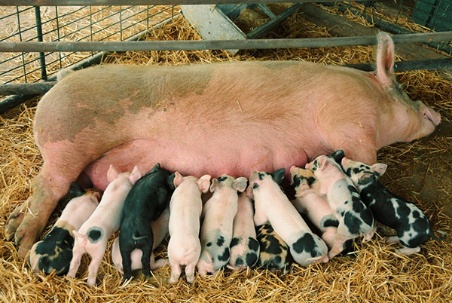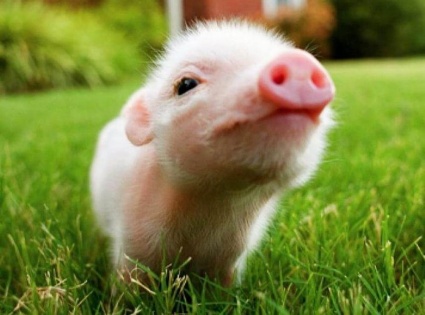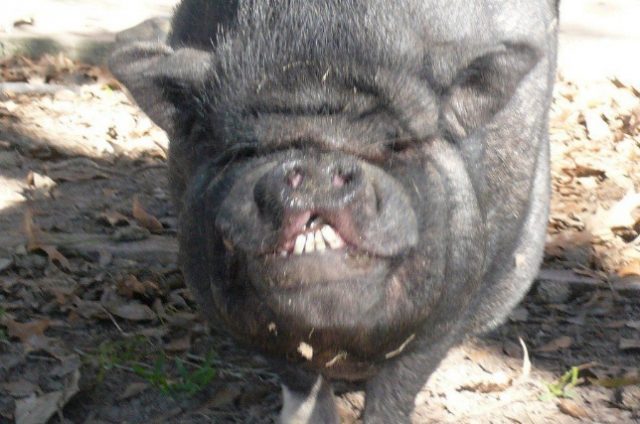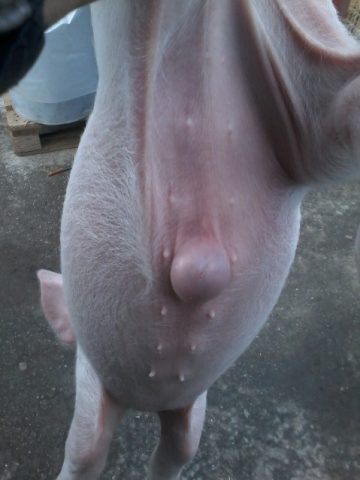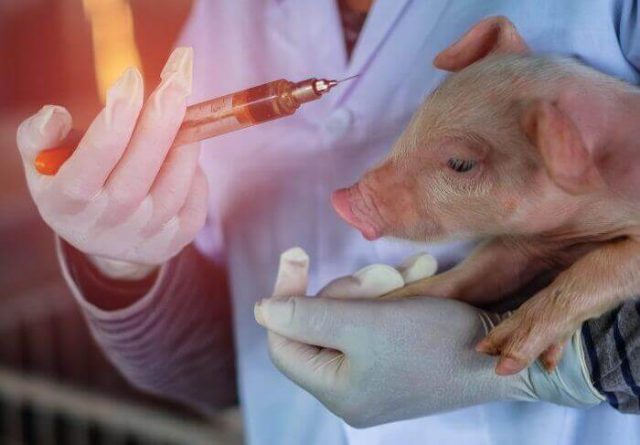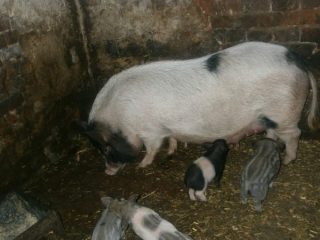Content
- 1 Why is lack of appetite dangerous in piglets and pigs?
- 2 Is the piglet healthy?
- 3 A pig or piglet does not eat well: reasons and how to fix it
- 3.1 Congenital pathologies
- 3.2 Lack of vitamins, minerals or micro- and macroelements
- 3.2.1 Avitaminosis
- 3.2.1.1 Vitamin deficiency A
- 3.2.1.2 Treatment
- 3.2.1.3 Vitamin deficiency C
- 3.2.1.4 Treatment
- 3.2.1.5 Vitamin deficiency E
- 3.2.1.6 Vitamin deficiency B₂
- 3.2.1.7 Symptoms
- 3.2.1.8 Treatment and prevention
- 3.2.1.9 Pellagra (rough skin)
- 3.2.1.10 Symptoms of pellagra
- 3.2.1.11 Diagnostics
- 3.2.1.12 Treatment and prevention
- 3.2.1.13 Vitamin deficiency B₆
- 3.2.1.14 Treatment
- 3.2.1.15 Vitamin deficiency B₁₂
- 3.2.1.16 Vitamin deficiency D (rickets)
- 3.2.1.17 Treatment and prevention
- 3.2.2 Lack of micro- and macroelements
- 3.2.1 Avitaminosis
- 3.3 Presence of parasites
- 3.4 Erysipelas
- 3.5 Violation of feeding rules
- 3.6 Failure to comply with content rules
- 4 Prevention measures
- 5 Conclusion
Piglets eat poorly and grow poorly due to many factors that must be taken into account when keeping pigs. Sometimes the lack of appetite in pigs is attributed to stress, but this condition rarely lasts longer than one day, and the pig does not have time to stop growing. It's worse if the pig doesn't eat well for several days.Loss of interest in food is often associated with an infectious disease or parasites.
Why is lack of appetite dangerous in piglets and pigs?
Pigs are greedy animals. If a piglet doesn't eat well, it has problems. Fasting in itself is not dangerous for a fattened pig, but it is the first sign of other problems.
Hunger strike is dangerous for newborn piglets. They still have neither fat reserves nor a fully developed gastrointestinal tract. If the piglet does not eat well in the first few days, it may die of starvation. Weak piglets, which receive the merest teat, grow poorly because they cannot eat properly.
Is the piglet healthy?
Before purchasing a pig, the productive direction of the pig is first determined. Having found a suitable breed, they take a closer look at the behavior of the piglets. Any signs of a good pig will be useless if the brood is sick.
A healthy pig, when trying to pick it up, will throw a tantrum throughout the entire area, calling for the pig. And it is better that the pig is securely closed. If the piglet is silent or squeals quietly, this is a sign of illness or severe weakness of the baby. When buying at the market, you should not believe the seller’s assurances that the piglets are simply tired, have run around and want to sleep. Full of strength, the pig will squeal and wake up from sleep. The piglet's eyes should be clear and shiny, without signs of "nitrous".
You cannot buy a pig in a bag where it was placed “for the convenience of the buyer.” All the piglets are silent in the bags. At one time, this was the source of the saying “buying a pig in a poke.” There was a custom in Rus' to buy young pigs directly in bags, only after estimating the weight of the piglet on your hand. Since all animals are silent in a closed dark space, unscrupulous sellers sold cats instead of pigs.The weight of a month-old pig was exactly equal to that of an adult cat. If a pig in a sack is silent, it is impossible to understand whether it is healthy.
After you have decided on the health of the piglets you are looking after, you need to pay attention to the size of the littermates. Pigs in a litter often have 1-2 piglets that are much smaller than the rest. This piglet eats very well, but grows poorly. There is no need to take it, even if they offer to sell it at a discount. On large farms, such piglets are destroyed immediately.
Exterior features
After the health and basic prospects for fattening have become clear, attention is paid to the pig’s exterior features. A good pig has a wide chest and a strong, straight back.
Legs are straight and strong. The assessment of leg length will depend on the chosen direction of fattening the pig. Long legs are good for a pig intended for meat. If you plan to fatten for lard, you need to take a short-legged pig. Breeds of meat pigs grow to full size slowly, but gain weight quickly as they build up meat. A short-legged, greasy pig will quickly stop growing and begin to gain fat.
The issue of a ring tail as a sign of a good piglet is controversial. Vietnamese pot-bellied pigs have drooping tails. And this breed of pig is not the only one in the world. In addition, sometimes piglets' tails are docked so that they do not bite them off each other due to vitamin deficiencies or mineral deficiency.
Perhaps the owner docked them to hide the necrosis of the tip of the tail due to vitamin B₆ deficiency.
But if the question is about choosing a pig of the large white breed, then it should not only have a tail with a ring, but also large pink, forward-facing ears.
In other breeds of pigs, little attention is paid to the color of the ears, their size and the degree of lopsided ears. The main thing: the inside of the pig's ears must be clean. A scab inside the ear indicates the presence of a sarcoptic mite.
You need to pay special attention to your piglet's teeth and bite. On the lower jaw, the incisors are razor-sharp and point forward. If the lower jaw is shortened, the pig eats poorly and swallows food poorly, since the lower incisors interfere with it, wounding the palate. If the lower jaw is too long, there will be fewer problems, but such a pig will grow slower than its littermates.
To check the bite, you will have to wait until the piglet squeals to his heart's content. After the pig closes its mouth, you need to carefully part the lips and evaluate the bite.
If the piglet has a temper, he will bite. Checking a pig's bite is difficult. It is viewed from the front, and the pig has a sedentary snout in front. The position of the piglet's lower jaw is assessed by looking at it from below. The undershot will be clearly visible.
A “meat” pig at the age of 1-2 months has a heavy head, while a “greasy” pig has a light, snub-nosed head. When purchasing a purebred pig, deviations from the norm often indicate inbreeding. If you are buying a pig of an unknown breed, these signs will help determine the type of pig you need.
Eating food
Selected pigs are assessed for their desire to eat food. You can look after the most greedy piglets even at suckling age. When purchased, the pig should already be ready to eat on its own.The one-month-old piglet is already eating on its own, but continues to suckle the sow. At this age, it is difficult to assess how fully he will eat on his own. One-month-old piglets may still not be able to eat or “suck” liquid food well. At 2 months, piglets already know for sure that they need to open their mouths wider and plunge their snout into the swill as deeply as possible. So you get more in one sip. The most greedy pig from those looked at must be chosen. The piglet eats well and grows well. If a piglet continues to pick at food even at 2 months, it will either grow poorly or be sick.
A pig or piglet does not eat well: reasons and how to fix it
All the reasons why pigs eat poorly and do not grow can be divided into 3 large groups:
- poor diet;
- diseases;
- genetic problems.
The owner has to take a comprehensive approach to preparing a diet for pigs. It is impossible to focus only on the calorie content of a product, without taking into account vitamins and minerals. With monotonous feeding, pigs experience a shortage of some elements and an excess of others.
Diseases of pigs, even non-contagious ones, are almost all characterized by a lack of appetite. The piglet does not eat well and prefers to lie down even because of the pain in his leg. The pain is caused by the fact that the leg was injured while playing with littermates.
Congenital pathologies
Genetic problems usually result from inbreeding, to which pigs are very sensitive. One of these problems, which can hardly be called a pathology, is dwarfism. In this case, the piglets grow poorly and often grow 2 times less than normal. But they have an excellent appetite. Such “mini-pigs” eat a full portion of their large relatives.There are no other developmental disorders associated with dwarfism.
Genetic abnormalities that lead to poor food intake and lack of growth include malocclusion, umbilical and inguinal-scrotal hernias, and gastrointestinal pathologies.
Malocclusion
It can never be acquired, no matter what some breeders of pigs, dogs, horses and other animals say about it. When snacking, the problem is practically unnoticeable during suckling age. In older piglets, overbiting also interferes much less with living and eating than underbiting. A pig is an animal adapted to dig roots out of the ground with its lower jaw incisors. Digging in the soil, a pig with a snack wears down its teeth, and they do not cause him much inconvenience.
The situation is worse with underbite. Piglets are born with already “ready” milk teeth. With an underbite, the incisors rest against the palate and interfere with eating already in the suckling period. Such piglets grow poorly and gain weight from the first days. With age, the problem will worsen, as the incisors will not grind down on the ground. Conscientious breeders immediately destroy such cubs, since the problem of underbite can only be resolved by breaking off the pig’s incisors.
Hernias
Hernias do not interfere with eating, they interfere with digestion of food. There can be three types:
- umbilical;
- inguinoscrotal;
- perineal.
The latter is rarely observed in pigs. It occurs as a result of rupture or stretching of the blind sac of peritoneum between the rectum and the bladder (males) or vagina (females). It is not congenital and occurs as a result of pushing during farrowing or prolonged severe pain in the rectum without excretion of feces. In piglets it can occur as a result of any gastrointestinal disease.
Umbilical hernia
This defect is considered hereditary.Most often occurs in multiparous animals, including pigs. A hernia occurs at the site of the umbilical ring, which did not close after the piglet was born. One of the main reasons for the appearance of umbilical hernias is considered to be inbreeding and violation of the technology of raising pigs.
But umbilical hernias in piglets can occur due to the umbilical cord being too short in relation to the uterus. This usually affects those piglets that are located at the anterior ends of the uterine horns. In this case, the tension of the umbilical cord expands the umbilical ring even before the piglet is born.
Some practitioners believe that umbilical hernias can occur due to piglets fighting for the nipple or crawling into holes that are too low. If the piglet strongly arches its back, the ventral abdominal wall becomes tense and the umbilical ring expands. Also, a hernia in a piglet can occur due to the umbilical cord being torn off without first fixing the stump (pigs cannot bite the umbilical cord, like predators). There are also other reasons that can lead to umbilical hernias in piglets. But there is no reliably established reason.
Symptoms and treatment
There is a swelling at the site of the navel. When you press deep into it, you can sometimes feel the umbilical opening. If the hernia can be reduced, its contents, when pressed, are displaced into the abdominal cavity. When part of the intestine falls into the hole, you can feel its peristalsis.
With strangulated hernias, the animal is restless. Pigs may vomit. The swelling is hot and painful as peritonitis begins to develop.
Treatment of a hernia is always surgical. If reducible, the operation may be planned. With a strangulated injury, minutes count, and surgical intervention must be performed immediately.
Inguinoscrotal hernia
An inguinal/scrotal hernia is a prolapse of the intestine between the scrotum and the common tunica vaginalis. Introvaginal – prolapse between the testis and the common vaginal membrane.
The reasons for the formation of such hernias are genetics or metabolic diseases:
- rickets;
- exhaustion;
- avitaminosis;
- bloating;
- diarrhea.
May occur due to tension in the abdominal wall.
Symptoms and treatment
The skin of the scrotum hangs down on one side and is smoothed out from wrinkles. The contents of the scrotum are soft and painless. Treatment is only surgical. The inguinal rings are sutured.
Congenital anomalies of the gastrointestinal tract
There can only be a genetic problem here, since the anomaly begins in the embryonic period. During normal development of the embryo, the blind end of the intestine connects with a protrusion of the skin, forming the anus. If something goes wrong, there are possible options for incorrect development:
- smooth skin instead of the anus, but under the skin there is a well-developed rectum with a blind end;
- a skin opening is present, but the rectum ends in the pelvic cavity as a blind pouch;
- there is no cutaneous opening, the rectum is short and ends deep in the pelvic cavity with a blind end;
- In pigs, the rectum can open into the vagina in the absence of an anus.
Treatment in all cases is only surgical. With piglets, the issue is usually resolved more simply: they are killed immediately.
Lack of vitamins, minerals or micro- and macroelements
Often, any problems with growth and weight gain in piglets are attributed to a lack of vitamins. And so it is. With any type of vitamin deficiency, piglets stop developing and do not grow. But the same thing occurs when there is a lack of micro- and macroelements in the pigs’ diet.Usually this point is overlooked, although there are areas where pigs do not grow not because of vitamin deficiencies, but because of the lack of necessary microelements in the soil.
Avitaminosis
The most famous vitamins are: A, E, C and group B. The remaining vitamins have less influence on the formation of a growing organism. But a lack of any of these vitamins leads to slow growth and development of the pig. Although, with vitamin B deficiency, the pig does not have time to stop growing. He dies a few days after the appearance of clinical signs of vitamin B deficiency.
Vitamin deficiency A
Occurs when the carotene content in feed is low. With vitamin A deficiency, pigs gain weight poorly and then lose weight. General signs of vitamin deficiency:
- anemia;
- weakness;
- exhaustion;
- eye diseases;
- eczema and dermatitis;
- drying and peeling of the skin;
- abnormal growth of the hoof horn;
- impaired coordination of movements;
- sometimes paralysis and convulsions.
Due to general weakness, pigs eat poorly. Vitamin A deficiency can also occur with a nutritious diet if carotene is poorly absorbed.
Pregnant pigs experience:
- endometritis;
- infertility;
- abortions;
- retention of placenta.
A decrease in fertility has been recorded, but one cannot be sure that the brood is small due to vitamin deficiency and not due to other factors. In boars with vitamin A deficiency, spermatogenesis is impaired.
Piglets suffering from vitamin A deficiency do not grow, eat poorly and stop developing. They often suffer from bronchopneumonia.
Treatment
Providing pigs with feed rich in carotene:
- carrot;
- green grass;
- beet;
- grass flour in winter;
- silage and haylage.
Fortified fish oil is added to the feed: piglets 20 ml 2 times a day; for adult pigs 75 ml once a day.Vitamin A injections are given subcutaneously or intramuscularly: 75 thousand IU for pigs, 35 thousand IU for piglets daily.
To prevent vitamin deficiency, depending on the season, pigs are provided with:
- fresh grass;
- sprouted grains;
- hydroponic greens;
- pine needles or pine flour;
- red carrots;
- herbal flour.
If necessary, an oil solution of vitamin A is added to the feed.
Vitamin deficiency C
Pigs are one of the animals most affected by this type of vitamin deficiency. This is due to the fact that the owners, wanting to fatten the pig faster, give it mealy feed:
- porridge;
- boiled potatoes;
- compound feed
Vitamin C is destroyed when heated. A pig that eats only cooked foods will inevitably develop vitamin C deficiency. Another cause of the disease is a disruption of the gastrointestinal tract, when the vitamin ceases to be absorbed and synthesized. Less common is vitamin C deficiency, which develops as a result of infections, intoxication and inflammatory processes.
Clinical signs of vitamin C deficiency in animals are different. In pigs, vitamin C deficiency is characterized by:
- growth retardation;
- hemorrhages;
- pallor of the skin and mucous membranes;
- unpleasant odor from the mouth;
- loose teeth;
- necrosis and ulcers in the oral cavity.
The symptoms of vitamin deficiency are very close to the description of scurvy in humans. Vitamin C deficiency in pigs is precisely scurvy.
Treatment
Treatment of vitamin deficiency consists of providing pigs with feed rich in vitamin C: fresh greens, unboiled potatoes, milk. Pigs are given additional vitamin C: piglets 0.1-0.2 g; adult animals - 0.5-1 g. fed with food, with water or given injections.
Vitamin deficiency E
Accompanied by metabolic disorders.The growth of piglets does not stop, since in young animals the result of vitamin deficiency is white muscle disease. Action must be taken immediately. After a few days, the changes in the body become irreversible and the pig can only be slaughtered. In adult pigs, vitamin E deficiency is characterized by degenerative changes in the reproductive system.
Treatment consists of developing a complete diet and, if necessary, adding an oil solution of vitamin E to the feed.
Vitamin deficiency B₂
The main features are similar to vitamin B₅ deficiency (pellagra). Occurs due to low vitamin B₂ content in feed or as a result of gastrointestinal and liver diseases.
Symptoms
Pigs don't grow, lose weight, and don't eat. Gradually they develop anemia. Dermatitis appears on the skin of piglets. Eye diseases develop. Stubble falls out on the back.
Treatment and prevention
Pigs are omnivores, so they are provided with feed of animal origin high in B vitamins. As a preventive measure, the diet is balanced with protein.
Pellagra (rough skin)
The disease also refers to vitamin deficiencies. Rough skin is the popular name for this type of vitamin deficiency, which comes from one of the symptoms. Other names for pellagra: vitamin deficiency B₅ (PP). The vitamin itself has less memorable names:
- niacin;
- a nicotinic acid;
- antipellargic factor.
The vitamin is synthesized by microorganisms in the gastrointestinal tract, in plants and, with normal metabolism in pigs, from tryptophan.
The latter is an essential amino acid found in animal protein and soy. Pigs are usually not fed meat, and soybeans are not grown in Russia, and it is not customary to feed livestock with it. Grain feed is not able to provide pigs with vitamin PP.Corn is considered the best grain for fattening piglets; the owner often feeds it to the pigs. But a large percentage of corn in the feed causes a lack of B vitamins and tryptophan in pigs, which leads to pellagra.
Symptoms of pellagra
Characterized by damage to the intestines, skin and central nervous system. It can occur in 2 forms: acute and chronic. In piglets, an acute form is more common, which looks like skin eczema with the formation of black scabs. For the first 2 weeks, the rashes are located symmetrically. Later they spread to the entire body of the piglet. Cracks and dried scabs on the legs cause pain to the animal, which is why the pig often stops moving. The piglets are not growing well.
In addition to eczema in young animals, the following is noted:
- swollen mucous membrane of the gums and cheeks with small bruises;
- salivation;
- anemia;
- sore tongue;
- digestive disorders;
- growth retardation;
- reluctance to eat;
- convulsions;
- impaired coordination of movements;
- desire to lie down.
Pregnant pigs give birth to non-viable offspring that die in the first days. A decrease in fertility is also noted. Abortions are possible with a simultaneous deficiency of vitamin B₂.
The chronic form of pellagra develops slowly, the symptoms are weak and blurred. Piglets get sick most often in winter and spring, when there is a lack of vitamins in the diet. In industrial pig farms with a mixed feed diet, vitamin B₅ deficiency occurs all year round.
Diagnostics
The diagnosis is made based on the external symptoms of vitamin deficiency: disturbances in the gastrointestinal tract, damage to the central nervous system and skin. The diagnosis is confirmed by pathological studies:
- cheesy coating on the mucous membranes of the colon and rectum;
- ulcers on the intestinal mucosa;
- fatty liver;
- atrophy of bones, endocrine glands, muscles.
When diagnosing, a lack of cobalt and vitamin B₁₂, paratyphoid fever, scabies and dysentery are excluded. Treatment and prevention are carried out using the same methods. Only the dosage of the drugs differs.
Treatment and prevention
Feeds containing large amounts of B vitamins are introduced into the diet:
- legumes;
- animal protein;
- wheat bran;
- herbal flour;
- fresh grass if possible.
Vitamin B₅ is administered orally in a dose of 0.02 g 3 times a day for a course of 2 weeks. Injections are made intramuscularly or subcutaneously in a dose of 1-2 ml once a day. Also within 2 weeks.
Prevention of vitamin deficiency involves constantly providing pigs with nutritious feed. If necessary, vitamin B₅ is added to the feed at the rate of 13-25 mg per 1 kg of dry diet.
Vitamin deficiency B₆
Prolonged feeding of pigs with moldy, spoiled and boiled feed contributes to the occurrence of vitamin deficiency. Although a pig will eat fish with pleasure, you cannot get carried away with such a source of protein. Fish contributes to vitamin deficiency.
Signs of vitamin deficiency:
- pigs grow and develop poorly;
- the activity of the central nervous system is disrupted.
Pigs often experience perversion of appetite, gastrointestinal upset, and necrosis of the tip of the tail. Piglets develop skin lesions. Especially in the lower abdomen. Dermatitis appears around the eyes and nose.
Treatment
Vitamin B₆ deficiency is often not noticed and is rarely registered as an independent disease. Treatment is almost the same as for vitamin B₂ deficiency.For prevention, feed containing large amounts of pyridoxine is included in the diet:
- sprouted grain;
- greenery;
- dairy products;
- egg yolk;
- fruits.
1-4 mg of pyridoxine per 1 kg of feed is regularly added to food.
Vitamin deficiency B₁₂
Manifests:
- poor growth and development;
- progressive anemia;
- metabolic disorders;
- decreased immunity.
The skin may show signs of eczema.
Treatment is carried out by including animal products in the diet.
Vitamin compatibility issues
B vitamins can be fat- or water-soluble. When mixed they are destroyed. Incompatible vitamins:
- B₁ and B₆, B₁₂;
- B₂ and B₁₂;
- B₂ and B₁;
- В₆ and В₁₂;
- B₁₂ and C, RR, B₆;
- B₁₂ and E.
This does not mean that different vitamins cannot be contained in the same product. This means that vitamins cannot be mixed in the same syringe or added to the same food.
Vitamin deficiency D (rickets)
If the piglet does not grow, the first thing to do is suffer from rickets. This is the most common problem when raising animals. Rickets develops with a combined deficiency of vitamin D, calcium and phosphorus in the body. But vitamin D starts the process, without which calcium cannot be absorbed. Rickets is chronic and develops gradually.
Main symptoms:
- piglets do not grow and stop developing;
- try to eat inedible objects (lick white walls, eat soil);
- diarrhea;
- bloating;
- constipation;
- dull stubble;
- dry, inelastic skin;
- enlarged joints;
- lameness;
- pain and curvature of bones.
Tachycardia, anemia, and cardiac weakness appear as complications in the later stages of the disease.
Treatment and prevention
The diet of piglets includes feed rich in protein, vitamins A and D and minerals. Ultraviolet irradiation is carried out. An oil solution of vitamin D is injected intramuscularly. Yeast is fed.
The basis of prevention: calcium-rich food and long walks in the open air.
Lack of micro- and macroelements
When raising piglets, they usually do not focus on anything other than vitamins. The only exception is iron deficiency, since it manifests itself quickly, and piglets often die from nutritional anemia. But there are other elements that cause piglets to grow poorly.
Piglets grow poorly with hypocobaltosis, hypocuprosis and manganese deficiency. Piglets are less sensitive to cobalt and copper deficiency than other animals. But they can also get sick if these elements are absent from the diet for a long time.
Manganese deficiency is acutely felt by 2 types of domestic animals: pigs and cattle. With a manganese deficiency, piglets grow poorly, their bones are bent and coordination of movements is impaired.
Iron deficiency
Of all young domestic animals, piglets most often suffer from iron deficiency anemia. Wild pigs do not have such problems, since their piglets get the necessary amount of iron by digging in the forest soil. Domestic pigs are often kept on concrete floors. This is hygienic and convenient, but the piglets have nowhere to get iron if they don’t have time to go out to pasture. Nutritional anemia occurs most often during winter farrowing.
Immediately after birth, the piglet has 50 mg of iron “stored” in its liver. The daily requirement is 10-15 mg. The piglet receives 1 mg with milk. The rest he must “get” from the ground.The disease develops due to lack of access to soil. But the piglet stops gaining weight and loses weight not 5 days after birth, but only on the 18-25th day. It is at this time that signs of iron deficiency appear.
Symptoms of anemia
The main sign: pale mucous membranes and skin, appears on average 3 weeks after the birth of the piglet. By this time, diarrhea develops. The backs of sick piglets are hunched and they are shivering. The stubble is dull. Skin is wrinkled and dry. Piglets grow poorly and often die. Often, shortly before death, piglets become paralyzed in their hind legs.
Treatment and prevention
There is virtually no treatment, since measures must be taken in advance. If signs of anemia appear, the further prognosis is usually unfavorable.
For prevention, piglets are injected with iron-containing drugs on days 2-5 of life. There are many similar drugs; the dosage and timing of injections should be looked at in the instructions for the specific type. Ferroglucin is most often used in a dose of 2-4 ml. The first injection is given on days 2-5 of the piglet’s life. The piglets are injected with iron for the second time after 7-14 days.
Presence of parasites
Parasites that cause pigs to lose weight usually refer to worms. But there is another parasite that causes pigs to eat poorly and not grow: the sarcoptic mite.
This is an itchy itch that lives in the epidermis. As a result of vital activity, it causes scabies and inflammatory processes on the skin. Consequence of the disease: impaired skin respiration and exhaustion of the pig. Pigs do not eat because they are bothered by scabies and stress. Infection occurs through contact between a pig and a pig. Usually at one month of age. In pigs, sarcoptic mange occurs in 2 forms: auricular and total.
Signs of sarcoptic mange:
- the appearance of papules;
- roughening and thickening of the skin;
- stubble loss;
- peeling;
- severe itching.
A pig can be sick for 1 year, after which it dies. Pigs are treated by spraying or rubbing in acaricidal preparations.
Helminthiasis
Pigs can be parasitized by flat, round and tapeworms. Regardless of the biological classification of the parasite, infection with worms leads to weight loss in pigs. In some cases, this occurs gradually, as in metastrongylosis. Sometimes a pig loses weight rapidly, as with trichinosis. If a pig is heavily infected with Trichinella, it may even die after 2 weeks.
Treatment and prevention for helminthiasis are the same: the use of anthelmintic drugs. To prevent worms, they are driven every 4 months.
Pork tapeworm is also dangerous for humans, since humans are the final hosts of this 8-meter parasite. But in pigs, infection with pork tapeworm occurs without symptoms.
Erysipelas
Infectious diseases almost all lead to wasting of pigs. Erysipelas is one such bacterial infection that affects piglets between 3 and 12 months of age. The causative agent of swine erysipelas is very stable in the external environment. It can survive for several months in the corpses of pigs. It survives in indirect sunlight for up to a month, but direct sunlight kills the bacterium in a few hours. Preserved in salted and smoked pork. At temperatures above 70 °C it dies in a couple of minutes.
Symptoms
Pig erysipelas has 4 forms:
- lightning;
- spicy;
- subacute;
- chronic.
With the first two forms, the pig does not have time to lose weight, since after 2-8 days of the incubation period the severity of the disease increases very quickly, and the pig dies within a few hours (fulminant) or 3-5 days after the first signs of the disease. Lightning-fast flow is rarely recorded. Most piglets are 7-10 months old.
Signs of acute course:
- temperature 42 °C;
- chills;
- conjunctivitis;
- the piglet does not eat well;
- bowel dysfunction;
- blue skin of the peritoneum and submandibular space;
- sometimes erythremal spots.
The signs of the subacute form are similar, but less pronounced.
Subacute and chronic forms are also characterized by:
- anemia;
- arthritis;
- exhaustion;
- skin necrosis;
- verrucous endometritis.
In addition to the form of occurrence, swine erysipelas also distinguishes septic, cutaneous and latent types.
Treatment and prevention
The bacteria that cause erysipelas in pigs are sensitive to antibiotics of the tetracycline and penicillin groups. In addition to antibiotics, anti-erysipelas serum is used.
Prevention consists of vaccinating all pigs from 2 months of life, observing quarantine and living conditions.
Violation of feeding rules
Violation of the rules of feeding pigs leads not only to exhaustion and vitamin deficiencies. Even the sex of the pig influences the development of the diet. If a breeding boar eats a large amount of bulky feed, his sexual energy decreases. Watery foods reduce the number of viable motile sperm. Lack of minerals and vitamins reduces the fertilizing ability of a boar. For these reasons, boars are fed strictly according to standards.
Pregnant pigs are very sensitive to a lack of amino acids and vitamins, since they have almost no synthesis of microbial protein, vitamins and amino acids. With an unbalanced diet, pigs begin to get sick.
Their fertility and large-fruitedness decrease, and the balance of the litter is disrupted. Milk production decreases, causing suckling piglets to die. Based on the problems in newborn piglets, you can even determine what the pig lacked during pregnancy. But it's too late to fix this.
Pregnant pigs must eat succulent feed and grass/grass meal.
From the age of 3 days, piglets are provided with biologically pure red clay from a depth of at least 1 m. This prevents anemia without the use of injections of iron-containing preparations. From day 5, various mineral supplements are given. From a month onwards they are accustomed to succulent food. Piglets are weaned at 2 months and transferred to rationed feeding. Concentrates are given in the form of porridge, being careful not to unbalance the diet and not cause vitamin deficiency. Piglets begin to eat “adult” food after 1 month.
Failure to comply with content rules
When keeping pigs in groups, a homogeneous composition is selected. The piglets in the group must be of the same age and size, otherwise the strong will begin to oppress the weak at the feeders. Weak piglets will not be able to eat and will grow poorly, and then may even die completely.
Pregnant pigs are also collected in groups for fattening. The difference in the time of fertilization of different individuals should not exceed 8 days.
You cannot violate the area norms per pig. When kept in crowded conditions, pigs experience stress. In this case, piglets grow poorly. Pigs lose weight.
Newborn piglets and pigs are kept in a room with an air temperature of + 25-30 °C. If the temperature regime is violated, the piglets freeze, eat and grow poorly, and may die.
Prevention measures
Prevention depends on the reason why piglets are not growing or gaining weight. If these are infectious diseases, to prevent them it is necessary to comply with sanitary standards for keeping pigs.
It is easier to prevent vitamin deficiencies and mineral deficiencies by carefully preparing diets and taking into account the area where pigs are raised. The easiest way to prevent pigs from becoming stressed due to overcrowding. It is enough to provide them with a spacious walk.
Conclusion
Piglets eat poorly and grow poorly, usually due to the owner’s oversight, who did not take into account the nuances of feeding pigs. But an excess of nutrients in the diet can also be harmful. Sometimes hypervitaminosis is much worse than vitamin deficiency, and an excess of micro- and macroelements can cause poisoning in pigs.
